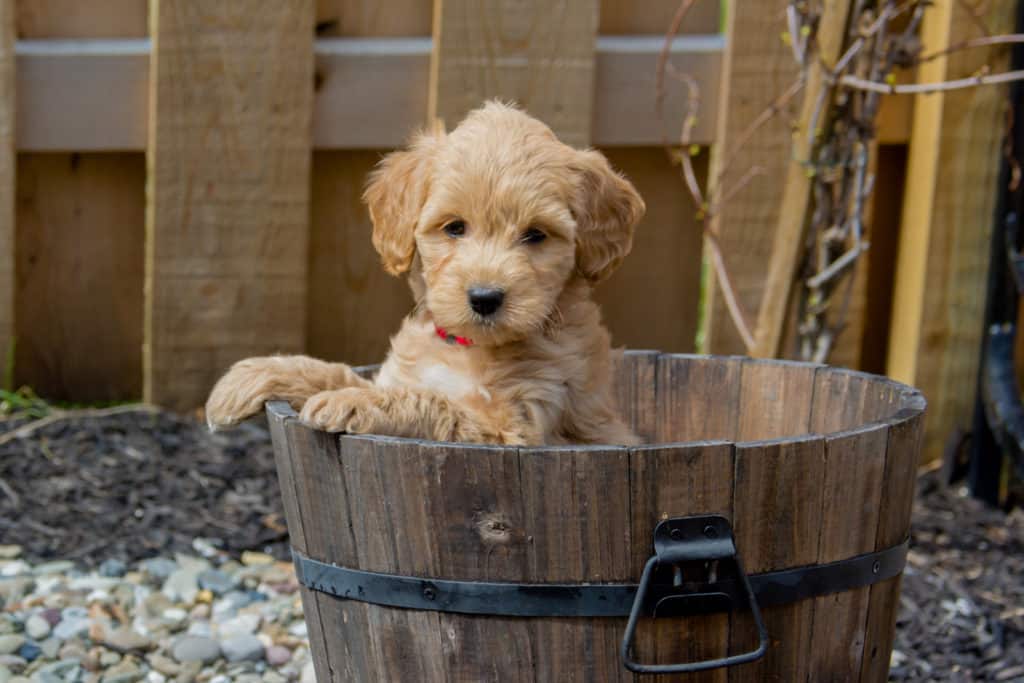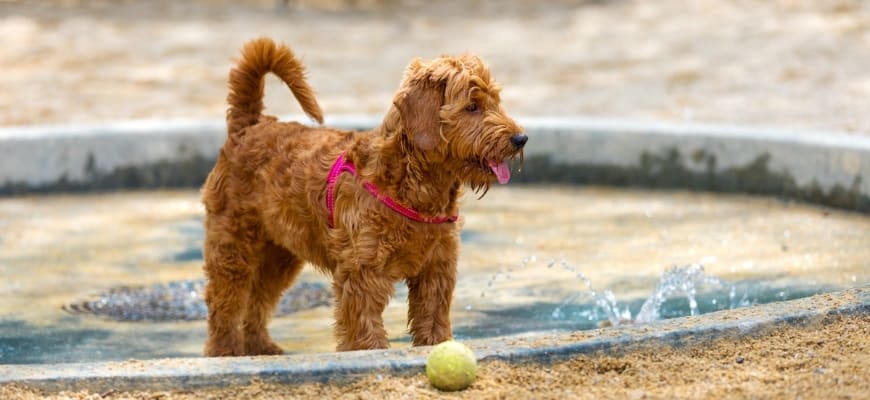Goldendoodles have seen a huge boom in popularity in the last decade, especially since the Covid 19 lockdown.
With families working and schooling from home, more people have time for a dog, and the Goldendoodle is the perfect choice for a family pet, being friendly, loyal, loving, and trainable.
The Goldendoodle’s popularity has meant super-high prices, generally starting at $2,000 for a well-bred dog. And the smaller the dog, the more people are prepared to pay. The latest fluffy concoction that’s appeared on the market is the Micro Goldendoodle.
Keep reading to find out why you should think twice about buying one of these tiny pups.
Table of Contents
What Is A Micro Goldendoodle?
The Micro Goldendoodle is the very latest fad breed in the trend for tiny dogs.
Micro Goldendoodles are also called Micro Mini Goldendoodles, Micro Petite Goldendoodles, and Micro Toy Goldendoodles. These little dogs are adorable and have the cuteness factor in spades, standing up to around 12 inches tall from paw to shoulder and weighing just 10 pounds.
Basically, these adorable little dogs look just like real-life Teddy Bears!
Micro Goldendoodle Summary
Size:
10 to 12 inches tall, 10 pounds in weight
Coat type:
Straight, wavy, or curly
Color:
Various (see list below)
Shedding:
Light
Trainability:
Quick learners, eager to please, very trainable
Intelligence:
Highly intelligent
Temperament:
Dependent on parents but generally friendly and affectionate
Grooming:
Brushing daily or every other day, depending on coat type
Exercise requirements:
A 20-minute walk and a few playtime sessions per day
Price:
$5,000 (yes, seriously!)
How Are Micro Goldendoodles Created?
A Micro Goldendoodle is a hybrid dog that’s created by crossing a Toy Poodle with a Golden retriever.
As smaller Goldendoodle types are more popular than standard sizes and command the highest prices, breeders wanted to create the tiniest Doodle possible. However, that approach presents ethical issues.
How so?
Well, most Micro Goldendoodles are multi-generational Mini Goldendoodles that are produced by using only the smallest or runt parents. That approach often results in improper inbreeding that produces puppies with serious genetic health issues. When two runts are crossbred, the puppies they produce are often sickly and weak, often succumbing to disease very early in their lives. Also, a runt often cannot carry a litter of puppies to full term.
For those reasons, the ethics of breeding Micro Goldendoodles and other teacup breeds are widely frowned on by responsible, experienced breeders.
A Different Approach

However, sometimes, ethical breeders will create a Micro Goldendoodle by using a Golden retriever, Cocker Spaniel, and Toy Poodle hybrid. That’s a more ethical way of breeding, although that crossbreed tends to produce slightly larger dogs, weighing up to 15 pounds.
However, as there are no official size standards for Goldendoodles since the American Kennel Club does not officially recognize the breed, you’ll often see these Goldendoodles advertised as “toy mini” or “micro-mini,” simply to generate more sales.
There are a few reasons to proceed with caution if you’re thinking of buying a Micro Goldendoodle.
Size
A full-grown Micro Goldendoodle only grows to stand between 10 and 12 inches tall at the shoulder, weighing just 10 pounds. In fact, some of these petite pups are no larger than an A4 sheet of paper!
That makes these micro-mini size of pups ideal for apartment living and city life, and it’s one of the reasons for the Micro Mini puppies’ growing popularity. However, small dogs have fragile bones and can be at risk from serious injury if they’re handled roughly. That’s a big consideration for you if you have kids who want to play with the dog or larger pets.
Temperament And Personality

One of the reasons for the Goldendoodle’s popularity is the breed’s fabulous, friendly temperament. These dogs are usually excellent with other pets and are totally trustworthy around small kids, too. That’s a big selling point that breeders use when advertising these newly created tiny Doodles.
However, the temperament of inbred, multigenerational hybrid dogs is not easy to predict, simply because you don’t know what genetic profile your puppy will take after the most. For that reason, I highly recommend that you insist on meeting your puppy’s parents before you commit. If both the parent dogs have the usual happy-go-lucky Goldendoodle personality, there’s a good chance that your puppy will turn out that way too.
Intelligence
You can be pretty confident that your Micro Goldendoodle will be super-bright! Poodles, Golden retrievers, and Cocker Spaniels are all working breeds that are bred to be intelligent, quick learners.
Trainability
As you would expect with such an intelligent breed, Micro Goldendoodles are just as trainable as their larger cousins.

These bright sparks can be taught basic commands, as well as a few fancy tricks with which to impress your friends! Also, potty training your tiny new furry friend should be a breeze.
This loving, eager-to-please breed responds best to praise and reward, so always use positive reinforcement training techniques when working with your puppy.
Exercise Requirements
Just because Micro Goldendoodles are very small dogs, that doesn’t mean they have low energy levels. On the contrary, these pups are pocket rockets, having every bit as much energy as their larger cousins.
That said, these little guys have short legs, so a 20-minute walk is probably all your Micro Goldendoodle will need, as well as a few interactive playtime sessions every day. So, if you’re not a particularly active family, a Micro Mini Doodle might be a good choice for you.
Shedding
Like all Goldendoodle types and sizes, the Micro Goldendoodle can have a straight, wavy, or curly coat.

Dogs with curly coats are the lightest shedders, making them a good choice for those that don’t want to spend time vacuuming up shed dog hair. Also, curly-coated Doodles are best-suited for a home with allergy sufferers. A curly coat doesn’t drop dander as copiously as a wavy or straight coat and so won’t trigger allergies as readily.
Unfortunately, a Goldendoodle puppy’s coat often changes as it matures. So, always tell the breeder if you want a specific coat type. The breeder will have a pretty good idea of how the puppies will turn out and can make a good choice of pup for you.
Coat Color
Goldendoodles can come in a huge variety of colors, including:
- Brown
- Apricot
- Cream
- Black
- Red
- Parti (two-color combination)
- Tan
- White
- Black and white (rare)
- Sable
- Brindle
- Merle
- Phantom
- Grey
- Blue
- Chocolate
- Silver
As you can see, there are plenty of gorgeous colors to choose from! Generally, the more unusual the color, the more expensive the puppies will be.
Grooming Requirements
Goldendoodles have a double coat. The outer coat consists of smooth guard hairs that repel water, wind, and the sun’s UV rays, keeping the dog dry and protected. The undercoat is soft and fluffy, insulating the dog from the cold in winter and keeping him cooler in the summer.
The undercoat is shed most heavily twice a year in line with the changing seasons of spring and fall. However, a minimal degree of shedding occurs throughout the year, as the dead hair is dropped and replaced with new growth. You need to brush curly coats every day to remove as much of that loose hair as possible and to prevent the coat from matting and tangling. Straight or wavy coats need brushing every other day.
Many Goldendoodle owners opt to shave or clip their pets. Shaving most of the fur off helps to prevent matting and keeps the dog looking neat and tidy. A trip to the groomer’s salon every six to eight weeks for a clip also includes a bath and nail trim for your dog. Pro grooming fees are often lower for smaller dogs, so owning a Micro Goldendoodle could save you money too.
Health Problems
Even though crossbreed dogs are reputedly healthier than their purebred counterparts, there are some inherited genetic health problems that can affect Goldendoodles.
Unfortunately, inbreeding can produce runts that are often riddled with potential health issues, including:
- Hip dysplasia
- Elbow dysplasia
- Hypoglycemia
- Heart defects
- Serious eye conditions, including PRA and cataracts
Ordinarily, we strongly advise potential puppy purchasers to ask the breeder to show them documentary proof that both the puppy’s parents have been DNA tested and health-screened to rule out these health issues.
However, plenty of health problems are caused by the inbreeding that’s required to produce such tiny dogs. So, that health testing won’t necessarily show up anything sinister.
Life Expectancy
Although smaller dogs generally live longer than large ones, that’s sadly not usually the case with runts. Often, these adorable little Doodles have poor general health and die relatively young.
The life expectancy of Mini, Medium, and Standard Goldendoodles is around 15 years. However, the Micro Goldendoodle generally only survives for approximately ten years.
How Much Do Micro Goldendoodles Cost?

If you’re still keen to welcome one of these tiny pups into your family, you’ll want to know how much you can expect to pay for that cute bundle of fluff.
Are you sitting down? Good! Because, despite their minute size, one of these sweet little Teddy Bears will set you back at least $5,000!
However, as these dogs are so small, feeding and grooming costs for them will be much lower than for a Mini or Standard Goldendoodle.
Don’t Get Ripped Off!
Needless to say, you can bet that puppy mills and backyard breeders have been quick to jump on the current fad for tiny dogs by churning out as many of these Micro Goldendoodles as they can, as quickly as they can.
So, proceed with caution, and don’t be tempted by a cheap puppy cost price. Remember that puppy mills sell in volume rather than striving to produce quality puppies, and if a breeder is offering Micro Goldendoodle puppies for sale at very low prices, that’s a massive red flag.
Before you make any commitment to buying a puppy, always visit the breeder. The dogs should be kept in clean, spacious conditions, and they should appear well-fed and happy. Ask to see DNA testing and health screening results for the parent dogs. Ideally, you want to know the breeding dogs’ lineage for at least three generations.
Final Thoughts

I hope you enjoyed our guide to the Micro Goldendoodle. If you did, please share.
Although a Micro Goldendoodle can make a wonderful pint-sized pet, the process of breeding these runts does present a risk. When runts are bred to other runts, there’s a greater chance that the puppies produced will be weak and sickly.
As an alternative, why not choose a Mini Goldendoodle instead of a Micro? Mini Goldendoodles are still small in stature, but they are typically healthier, more predictable, and bred ethically.
What’s your opinion on the current tiny dog fad? Tell us what you think in the comments box below.